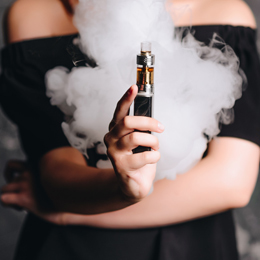
When electronic smoking devices were first introduced, they were marketed as a possible solution to help deter adults away from cigarettes and nicotine addiction. And while some folks did ditch tobacco to give them a try, so, too, did many of today’s youth. Now, some experts feel these teenagers are clouding their judgment by thinking what they are inhaling is inherently safe. What’s more is the fear that parents are even further in the dark—especially since there are also kids who have gravitated toward “vaping” highly concentrated THC oil to get high.
Vaporizers, e-cigarettes and vape pens are interchangeable terms among younger teens representing one object: an electronic device containing inhalable liquid. While cigarette use in the U.S. has had a huge decrease in middle school and high school students since 2011, electronic cigarette use has increased within the same time period.
As more research is done on vaping, the devices remain uncertified by the FDA as a quit-safe measure. And while some adults have turned to the devices in hopes to kick their pack-a-day habit, local authorities and physicians are concerned that theyare having the opposite effect on teens, turning them on to smoking, and forging a new pathway to addiction.
An increasingly popular electronic cigarette called Juul, which at first glance might look like a flash drive, has become a new phenomenon with teens. They are easily found in convenience stores, online and area vape shops, and they can be concealed in the palm of your hand, making them even more attractive to kids looking to sneak a puff in between classes, at home or out in public.
The Attraction to Vaping
Imagine your favorite flavor of candy, a delicious snack or refreshing drink and it’s probably one of the thousands of flavored e-liquid options for vape pens. A leading reason vaping is becoming more prominent among teens is through the appeal of these e-liquids such as vanilla or bubble gum. The whimsical flavors almost mask the reality that some ingredients inside are harmful, even if there’s no nicotine in the mixture.
In May, the FDA sent out 13 letters to companies selling e-liquids that had packaging resembling other products, ultimately misleading buyers. These flavors included whipped cream cartridges bordering a mini Reddiwip can, apple juice box packaging similar to kids’ juice boxes and packaging resembling a soda can.
“I have to say, they did a brilliant marketing scheme. It’s big tobacco. Big tobacco has taken over these vaping companies. … They put billions of dollars into their marketing campaign and they know what they’re doing,” says Nell Geiger, student assistance counselor at Bordentown Regional High School. “It’s just like the alcohol industry with these flavored drinks. It tastes so sweet and what’s the big deal and a lot of kids, that’s their response.”
Patrolman Robert Hansbury, school resource officer at Cherokee High School, says the packaging is easily attractable to kids. “The students don’t feel like they’re harming themselves even though they actually are,” Hansbury says. “They’re slowly becoming addicted to nicotine.”
A Risky Alternative
For teens, the multitude of flavors might make vaping seem like a fun and harmless activity, but there are consequences to smoking vape pens and minors might not have the knowledge to show discretion.
No matter the age, the same amount of damage is being done to teens’ lungs. Dr. Kate Cronan, pediatric emergency room doctor at Nemours DuPont, says although there aren’t as many harmful ingredients in vape pen liquids as there are in traditional cigarettes, it doesn’t make e-cigarettes and their emissions healthy.
One health concern that has risen with the usage of vape pens is the risk of developing oral cancer and lung cancer due to the carcinogens in the devices, whether the e-liquid contains nicotine or flavoring only.
A rare but more serious condition called bronchiolitis obliterans is in connection with the ingredient diacetyl, which is associated with causing significant scarring to the lungs’ small airways. The term is more commonly referred to as popcorn lung. The irreversible lung disease causes coughing, wheezing and shortness of breath, according to the American Lung Association.
“Now the other thing is the aerosol. It can contain some heavy metals and that can result in what is called respiratory distress, so trouble breathing,” Cronan says. “There is some thinking out there that some of the other chemicals in the aerosol can cause cancer.”
Because the brain is still underdeveloped in younger teens, Cronan says vaping can affect their ability to pay attention and learn in school. The big concern is the lack of understanding between parents and adolescents that the brain is still developing at this age and vaping can have an impact on the development process.
“The brain is still developing at this point [and] even into the mid-20s,” Cronan says. “It can actually interrupt or have an effect on some of the circuits in the brain. In other words, the way the brain works, like sending signals within the brain, it can have an effect on that.”
Physicians as a whole are still unsure of all the long term effects vaping can have on the body due to poor regulation in the e-liquids and the newness of the product.
Impending on Education
A new craze has swept over some South Jersey schools where students play a new game behind the backs of teachers, staff and administration. Whether it’s shuffling through the halls or sitting in on a lesson, a lot of studentsare participating in “The Challenge.” The purpose of the game is to inhale during class time without the teacher noticing while a friend videos the act for social media.
Vaping in the Lenape Regional High School district has increased significantly. Whether it’s sneaking it in bathrooms, hallways or classrooms, students are taking any opportunity, says Matt Webb, director of programs and planning at the Lenape Regional High School District.
“So 15 years ago, if a teacher was walking or an administrator [was] walking by a bathroom, they would smell the tobacco burning. Now, it’s much more concealable,” Webb says. “They have different flavors, might be vanilla or strawberry. It’s more difficult to catch than a traditional cigarette.”
As for the consequences, the Lenape district enforces a one-day suspension if caught possessing the item, a three-day suspension as a first consequence and a five-day suspension for the next, increasing as repercussions accrue. The electronic device is confiscated throughout any measure, similar to any other tobacco product on school grounds.
At Bordentown Regional High School, if a student is caught vaping in class, the school implements an in-school suspension and sets up three sessions with Geiger, whohas a prevention education conversation with the student about toxins in the device. Students and administration at the school created a peer-to-peer program where students meet to get educated on substance abuse and spread knowledge with their classmates. The group is also a way for those suffering from substance abuse to get help from school counselors.
An Addictive Tendency
Another concern with vaping is the risk of minors becoming addicted at a much younger age. Being exposed as an adolescent increases the possibility teens will develop a habit that could lead to potentially wanting the higher nicotine intake found in traditional cigarettes.
Nicotine can prime a young brain, making teens more vulnerable to addiction to other drugs like methamphetamine and cocaine, according to a U.S. Surgeon General’s report.
According to Dr. Michael Shore, an addiction specialist based in Cherry Hill and member of the board of directors of the American Society of Addiction Medicine, teens who use e-cigarettes are also more prone to a nicotine dependency. One in five eighth graders who use tobacco products—including traditional cigarettes—started their addiction with e-cigarettes, according to Shore.
“Many people who will say that it’s muchharder for them to get off of smoking and nicotine, whether it’s vaping or cigarette smoking, it’s worse for them to get off than heroin,” Shore says. “Nicotine can be very reinforcing; giving people energy, a sense of well-being, a calming effect and it’s so readily available. It’s so easy for people to get.”
Whether it’s nicotine, marijuana or opiates, Shore says sometimes there’s an underlying reason teens get introduced to these drugs. Youth with social anxiety disorder might feel more comfortable and accepted by vaping with their peers. Others might have depression and are self-medicating through the vape pens.
Some might not be addicted to any type of drug but the device itself.
“But some people are really just psychologically attached because addiction is more than physical,” Shore says. “It’s also psychological to the whole process of vaping.
… Some use it even when they really don’t have any drugs in there; no nicotine, no THC, [no] marijuana, nothing.”
Face to Face with the Law
Not only do nicotine and toxins exist in e-liquid, but teens are getting their hands on e-liquids laced with THC oils. The marijuana concentrate contains 40 to 80 percenthigher amounts of THC than flower. The oils have no discernible odor making it impossible to tell between the two.
The Gloucester Township Police Department made an arrest in May, confiscating nearly 3,000 vape cartridges laced with THC oil. Police wouldn’t have been able to differentiate between flavor or nicotine liquids from the drug-laced cartridges if it wasn’t for the labels.
“I think that’s been some of the buzz about schools. There’s a great concern I think across the state about these devices in school because the concern is they don’t know what’s in them,” says Gloucester Township Police Chief Harry Earle.
While Evesham is one of few that have newly enacted policies and laws for minors smoking vape pens, other areas like Gloucester Township are researching in the hopes of setting stricter regulations that the FDA has yet to implement. The FDA regulates tobacco products that were on the market up until May 2016 but has yet to put regulations on the newer devices made after that point.
Evesham Township passed an ordinance in April against youth possessing electronic cigarettes. Hansbury says the police department can now confiscate and destroy the device whereas before, any device had to be given back to the parents.
“We confiscate anything that the school already confiscated that is a tobacco product and then we proceed with a written warning and we speak with the parents and then anytime after that written warning, if they get caught again with an e-cigarette prior to turning 18, it’s a $50 fine,” Hansbury says.
Communication and education on vape pens are ways parents can get involved with their kids. Local authorities agree parents should take a step out of the dark and be in the know with new youth trends.
The Lenape High School District is keeping parents updated by bringing awareness to the issue through parent meetings, newsletters, motivational speakers and conducting outreach to middle school students.
“The most important thing is always to have an open dialogue with their teenagers, with their kids. I think especially what happens in our current culture, is that people are so busy,” Shore says. “Do we know what our kids are doing? Do we have dinner as a family once or twice a week where we’re engaging, where we’re talking? … And just by bringing it up and engaging that teenager, it’s likely to lead to better outcomes.”
To read the digital edition of South Jersey Magazine, click here.
Published (and copyrighted) in South Jersey Magazine, Volume 15, Issue 6 (September 2018).
For more info on South Jersey Magazine, click here.
To subscribe to South Jersey Magazine, click here.
To advertise in South Jersey Magazine, click here.












